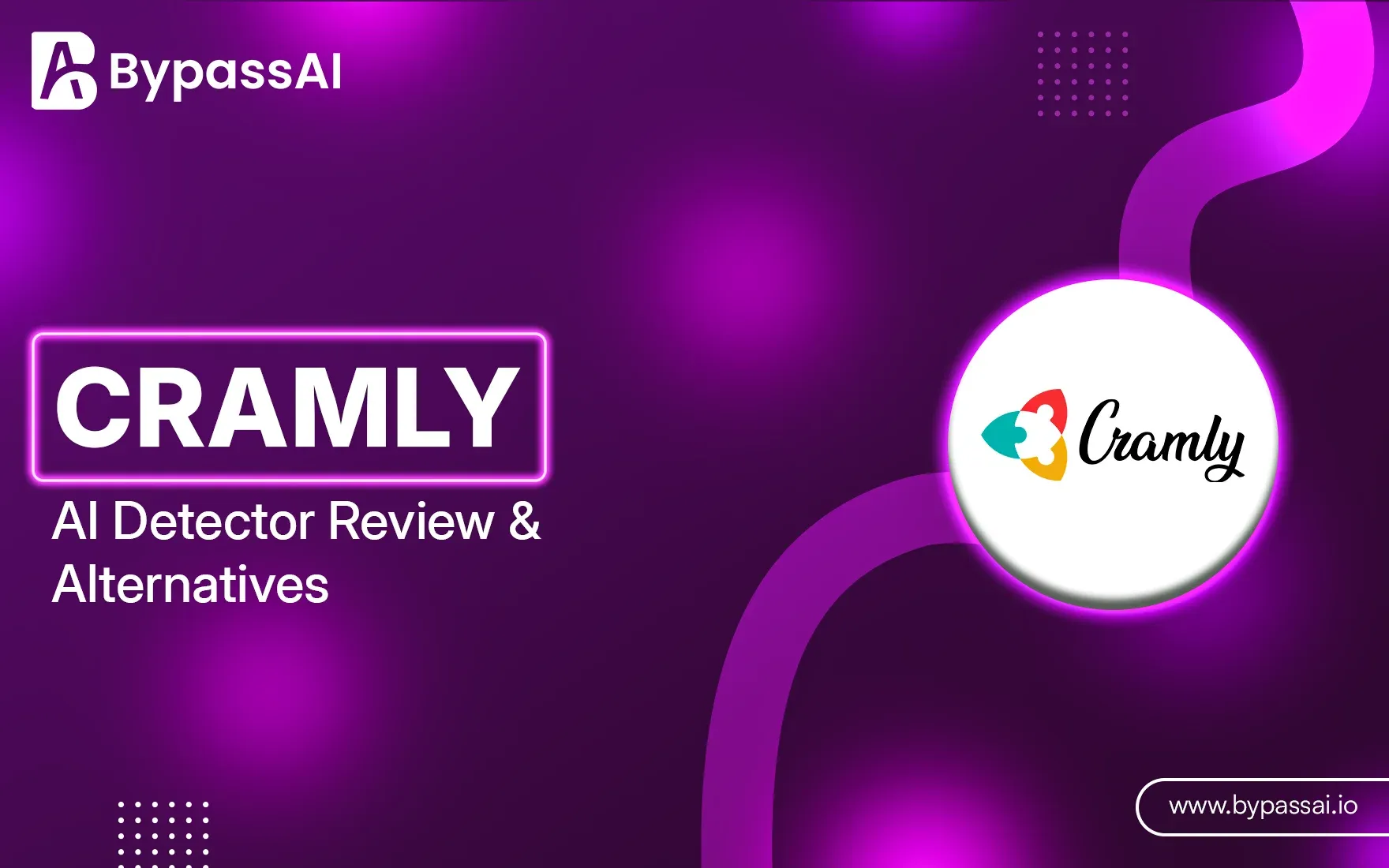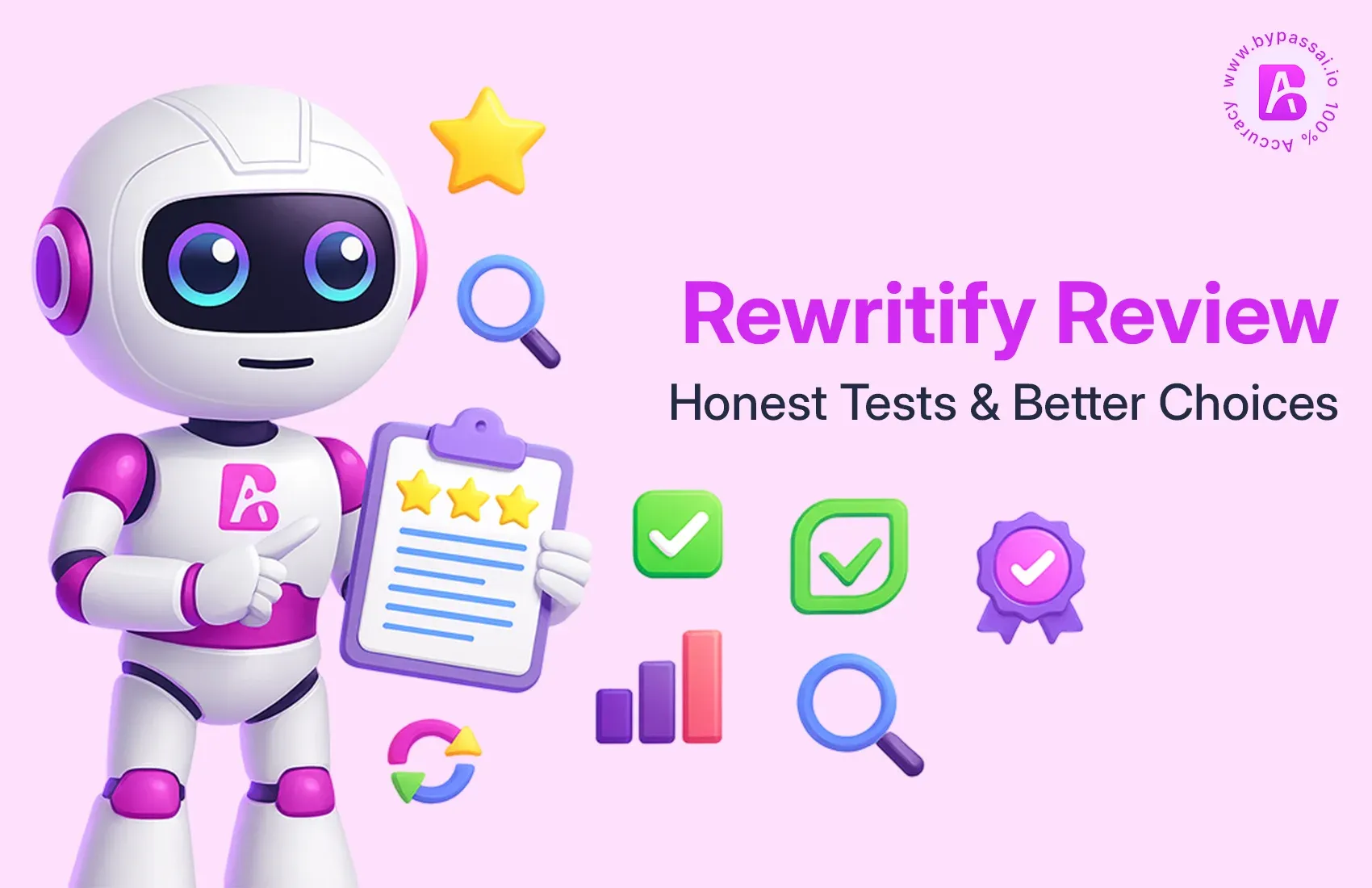Sign In
Welcome to Bypass AI! Sign in to continue your exploration of our platform with all its exciting features.
Forgot Password?
Don’t have an account ? Sign up
Sign Up
Embrace the Future with Bypass AI! Sign up now and let's rewrite the possibilities together.
You have an account ? Sign In
Enter OTP
We’ll send you an OTP on your registered email address
Back to Login
Forgot Password
We'll Send You An Email To Reset Your Password.
Back to Login
Enter OTP
We'll send you an email to reset your password.
Back to Login
Confirm Password
Please enter your new password.
TABLE OF CONTENTS
Quick Summary
What Is Cramly AI Detector?
How Does the Cramly.AI Detector Work?
Who Should Use It?
Why are people interested in platforms like Cramly?
Cramly AI Detector Pros and Cons
Accuracy Test of Cramly.AI Content Detector
Best Alternatives to Cramly AI Detector
Conclusion
FAQs
Artificial intelligence keeps moving on rapidly, with AI-generated content taking center stage in education, business, and digital marketing. Yet with its arrival, an important question arises: How can we detect AI-written text?
A relatively new entrant in the fields of content verification, Cramly AI detector detects AI-generated content, particularly from tools like ChatGPT, and is increasingly being accepted by students and educators. But does it live up to the hype? Or are there other alternatives?
This article analyzes Cramly.AI Detector, with regard to performance, strengths, and limitations, and subsequently presents the top 4 alternatives for 2025.
Quick Summary
Cramly AI Detector is a crudely handy tool meant for just a quick check of AI content for students and casual userswithout really going into the finer details and without checking the accuracy of the content itself. With a simple interface and integration with other Cramly tools, it is grossly underperforming in detecting AI-written text during testing.
High-quality checks for academic, business, or weighty use are better carried out by detection products like Bypassai.io, Originality.ai, Copyleaks, and Undetectable AI.
What Is Cramly AI Detector?
The software is highly esteemed as a very productive student platform, providing AI-assisted options for writing, paraphrasing, and summarizing. The AI Detector is an interesting, newer feature created to pinpoint any content forged by an AI model, such as ChatGPT or GPT-4.
Created with students and educators in mind, the Cramly AI Detector guarantees to:
- Identify any passages generated through AI
- Give a probability score (human and AI)
- Preserve academic integrity
Given its fame among Generation Z and TikTok influencers, the tool remains pretty much at the edge of scepticism regarding its accuracy and performance compared to more established brands.
How Does the Cramly.AI Detector Work?
Cramly's AI Detector is a web-based application for which the user:
Paste the text into the input box.
Click the button labelled "Check".
Waits for the result to be returned by the detector.
Usually, the detector offers a generic verdict such as "Likely AI", "Likely Human", or a percentage probability to aid human judgment as to whether or not a text has been generated by AI.
Cramly does not disclose its bases, unlike competing services like Originality.ai or GPTZero. The lack of this transparency makes it difficult to ascertain the tool's reliability.
Who Should Use It?
Cramly's AI Detector is a straightforward tool designed to help users identify AI-generated content. It's particularly useful for individuals seeking quick insights into the origin of a text. However, its effectiveness varies depending on the user's needs and the complexity of the content.
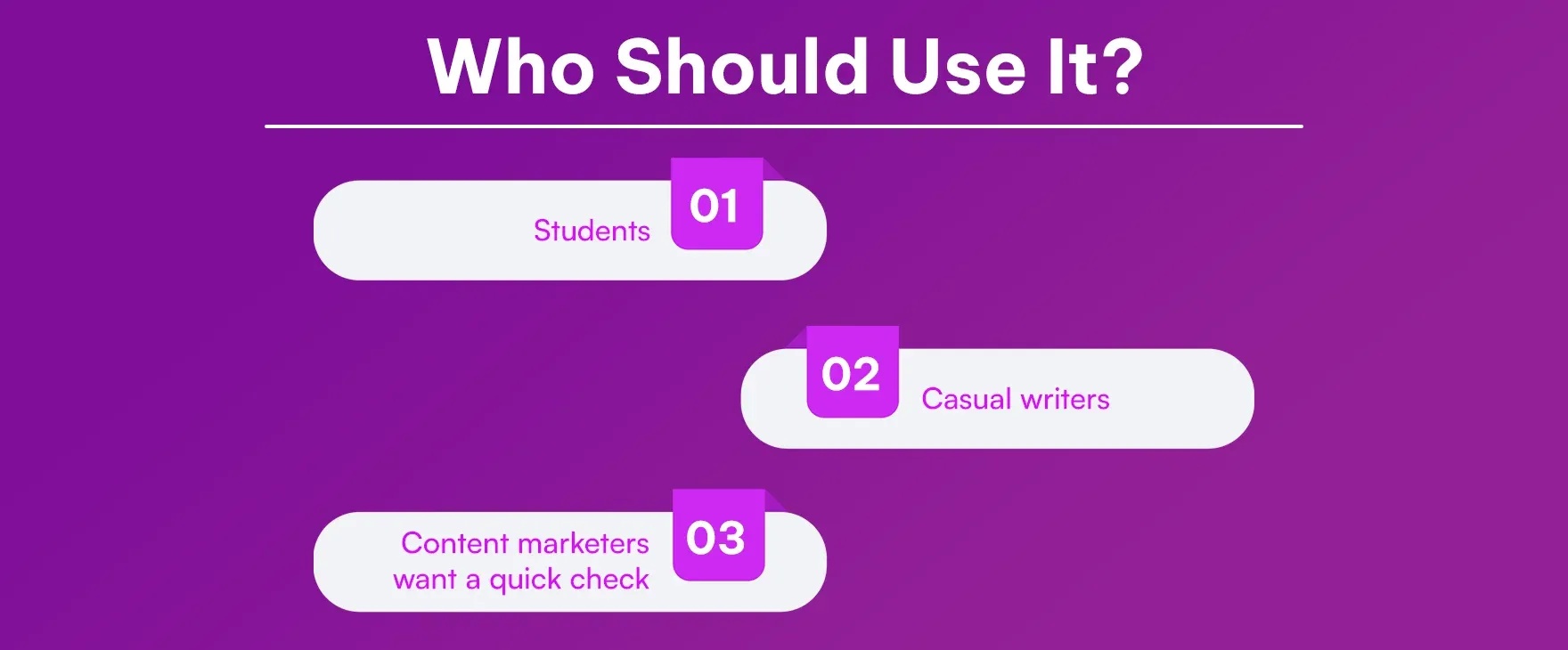
1. Students
Students who use AI tools for assignments or study support may want to quickly verify if their work appears human-written. Cramly lets you quickly check anything before submission, even if it might not be suitable for strictly academic purposes.
2. Casual Writers
Cramly furnishes a very quick-and-dirty AI check for hobby bloggers, journaling buffs, or part-time content guys-one that's useful when the issue of content authenticity is not of prime concern, and one is just looking for a basic assessment without any technical jargon.
3. Content Marketers
Marketers who generate large amounts of content might utilize Cramly to make certain that their AI articles are indistinguishable from human-written pieces. The service doesn't provide detailed reports, but it acts as a speedy initial verification step after which the content can be sent to clients or uploaded on platforms.
Also read this article : Justdone AI checker Review
Why are people interested in platforms like Cramly?
The use of software such as ChatGPT and Jasper has exponentially multiplied, with all institutions, employers, and publishers now looking at ways to verify content authenticity. Cramly, with writing assistance and detection bundled into one, is indeed a one-stop shop for an easy-going user unwilling to juggle several platforms on account of it.
Simplified for students and casual creators who need a quick AI content check. Formerly, it was cheap and spartan to the pincushion for the non-technical set looking to test/run a basic AI verification.
Cramly AI Detector Pros and Cons
Here are the pros and cons of Cramly AI Detector:
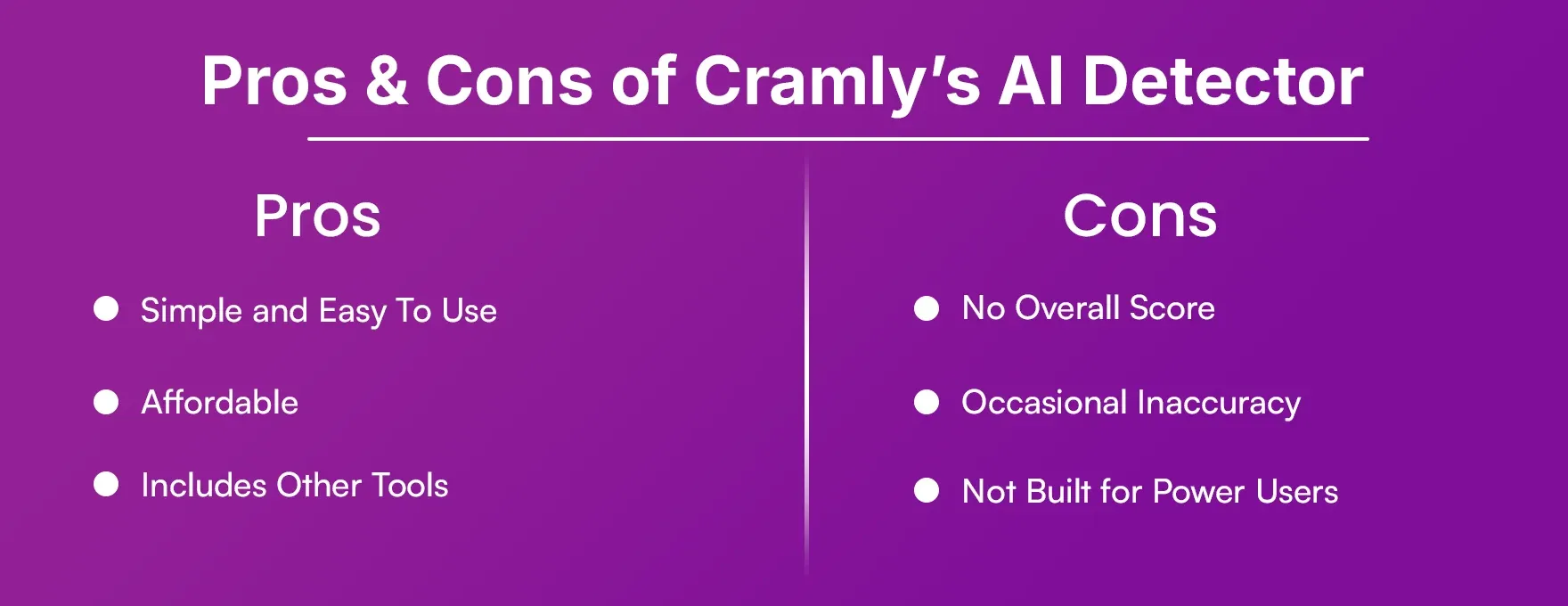
Pros Cramly AI Detector
Unrestricted use: You don't need to sign up just for basic detection work.
Student-friendly interface: Clean, fast, and straightforward in its operations.
Has an integration with other AI tools: Works hand-in-hand with Cramly's writer and paraphraser.
Cons Cramly AI Detector
Low accuracy: May falsely detect some legitimate content; might miss detecting some blatant ones.
Limited transparency: No demonstrations as to how one trains the detection model.
Not for professional use: It lags behind enterprise-grade detectors in terms of power.
Accuracy Test of Cramly.AI Content Detector
Test 1: AI-Generated Essay
In this test, we created an essay using a popular AI writing tool and ran it through both detectors.
AI Content Sample: Here we generate AI content through ChatGPT

AI content Check in bypassai.Io AI Content Detector

Result from Bypassai.io:
The detector flagged the content as 100% AI-generated, which aligns with the actual nature of the text.
AI content Check in Cramly AI Content Detector
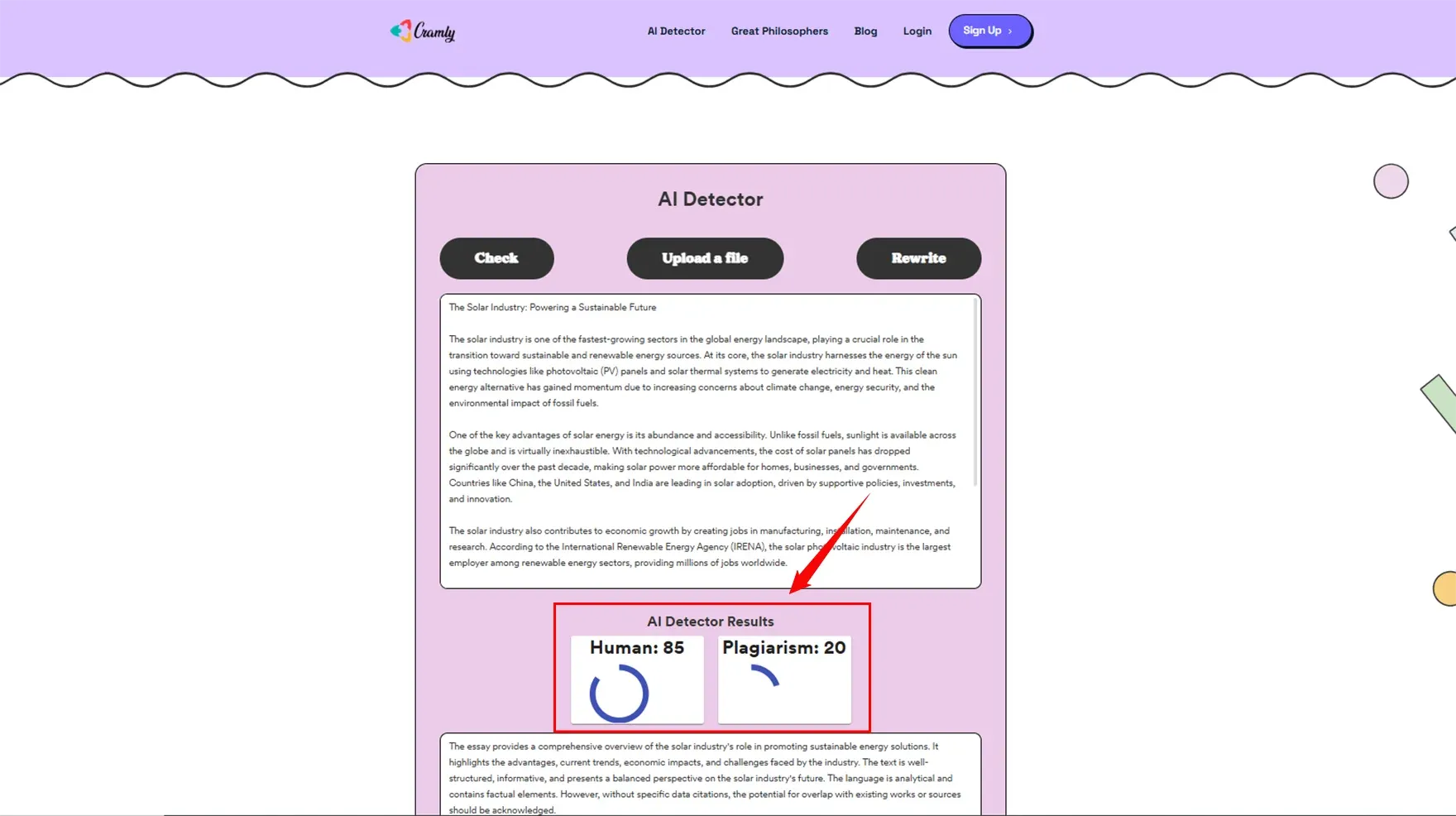
Result from Cramly:
Surprisingly, Cramly detected only 15% of the content as AI-written.
Insight: This key difference regards Cramly's detection algorithm possibly struggling to detect AI-like patterns in structured, academic-style content, having failed to catch 85% of AI-generated text in this instance.
Test 2: AI-Generated Blog Post
Next, we tested Cramly with an AI-written blog post designed to sound like a human content writer.
AI Content Sample: Here we generate AI content through ChatGPT.

AI content Check in bypassai.Io AI Content Detector
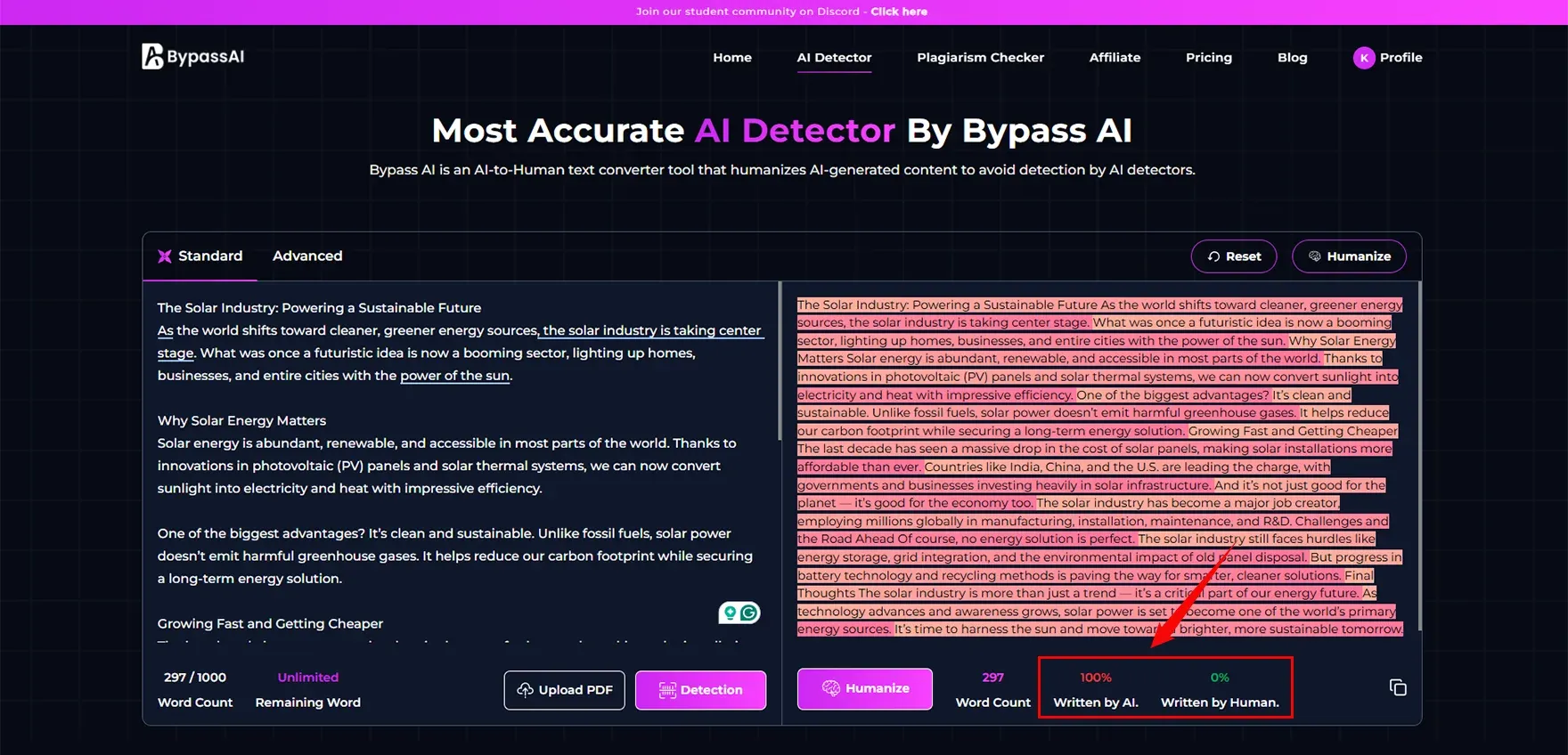
Result from Bypassai.io:
The tool once again correctly identified the content as 100% AI-generated.
AI content Check in Cramly AI Content Detector

Result from Cramly:
This time, Cramly flagged only 10% of the blog content as AI-written.
Insight: Though conversational in tone and typical of AI-generated blogs, Cramly missed out on identifying 90% of AI indicators, which again casts doubt on its efficacy in day-to-day content formats such as blogs.
Best Alternatives to Cramly AI Detector
If you're looking for a more accurate and dependable AI detection tool than Cramly, several powerful alternatives are available, each designed with different user needs in mind.
1. Bypassai.io
Bypassai is a platform with high detection accuracy, is widely loved among students, freelance writers, and content creators who need to verify that their AI-assisted content is not detected by different filters. It has a track record of accurately identifying AI-generated content and is perfect for users who want to keep on the right side of the rules while using generative tools without being too obvious.
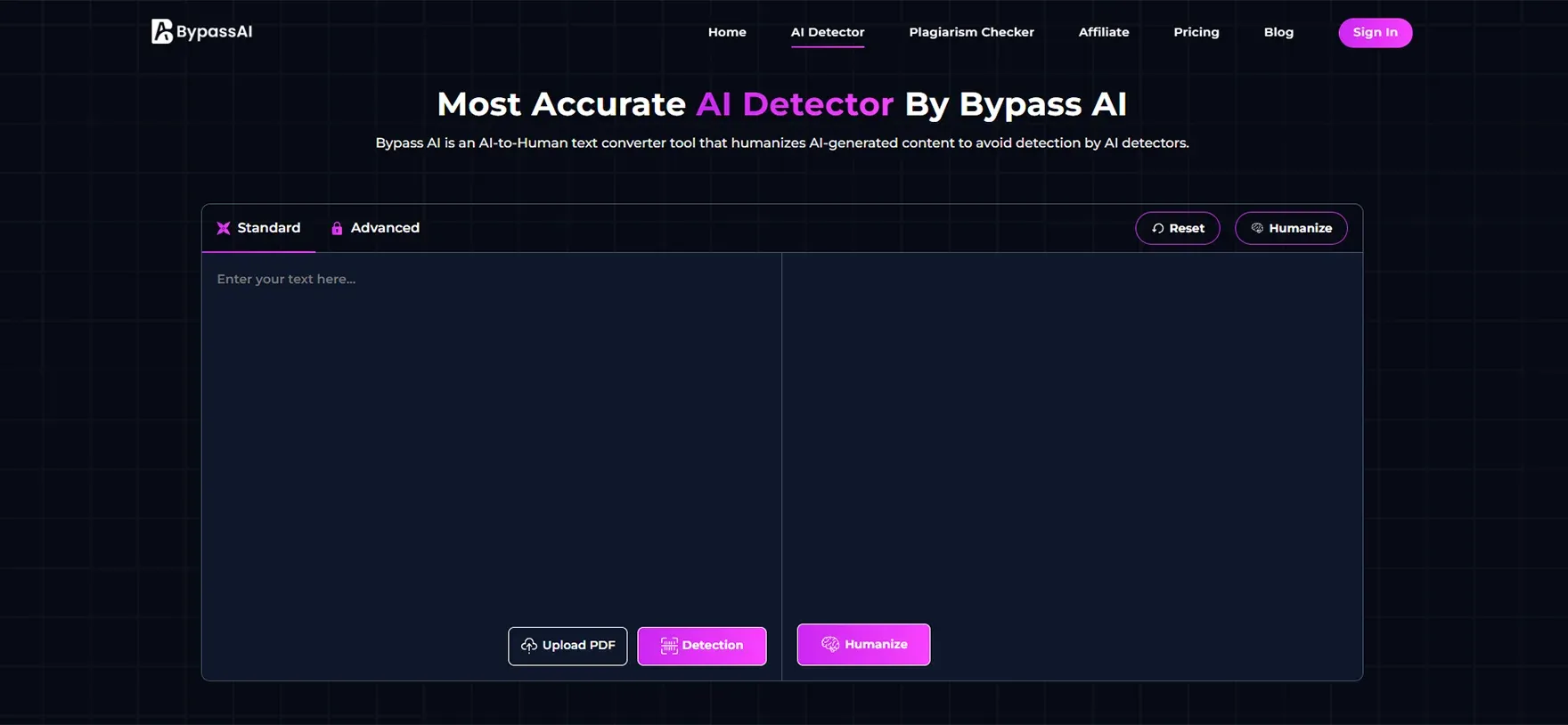
2. Undetectable AI
Undetectable AI platform is designed for advanced users who are mostly engaged in scientific or research writing. The main intention of the platform is not only to find AI content but also to provide rewriting options in order to humanize the AI-generated texts. It is a reliable tool for those who require the highest level of accuracy and the ability to rewrite texts while still making them similar to the original.

3. Copyleaks
Copyleaks is very popular among institutional and enterprise customers. It has a large network of educational and publishing partners and is relied upon for its strong plagiarism and AI detection features. Teachers and administrators who want enforcement at the classroom level or need to do compliance checks usually go for Copyleaks because of its easy-to-use and comprehensive dashboard and detailed analytics.
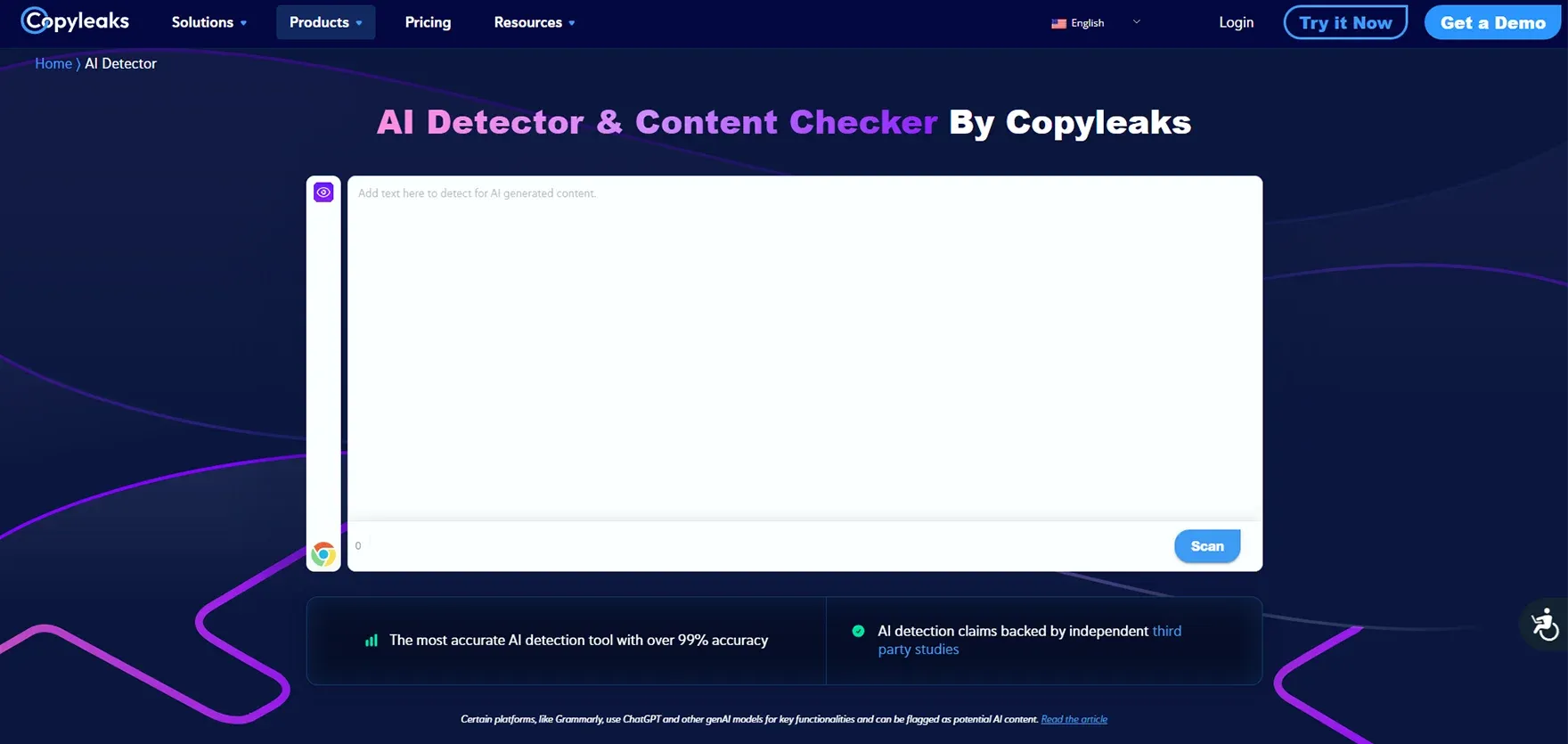
4. Originality.ai
Originality.ai, a platform created for content marketers, SEO specialists, and digital agencies, is capable of conducting intensive examinations of long-form content and website copy. It not only discloses the level of AI presence in the text but also allows one to perform plagiarism checks. This makes it a very important tool for those who want to launch authentic, top-ranking, and human-like content.
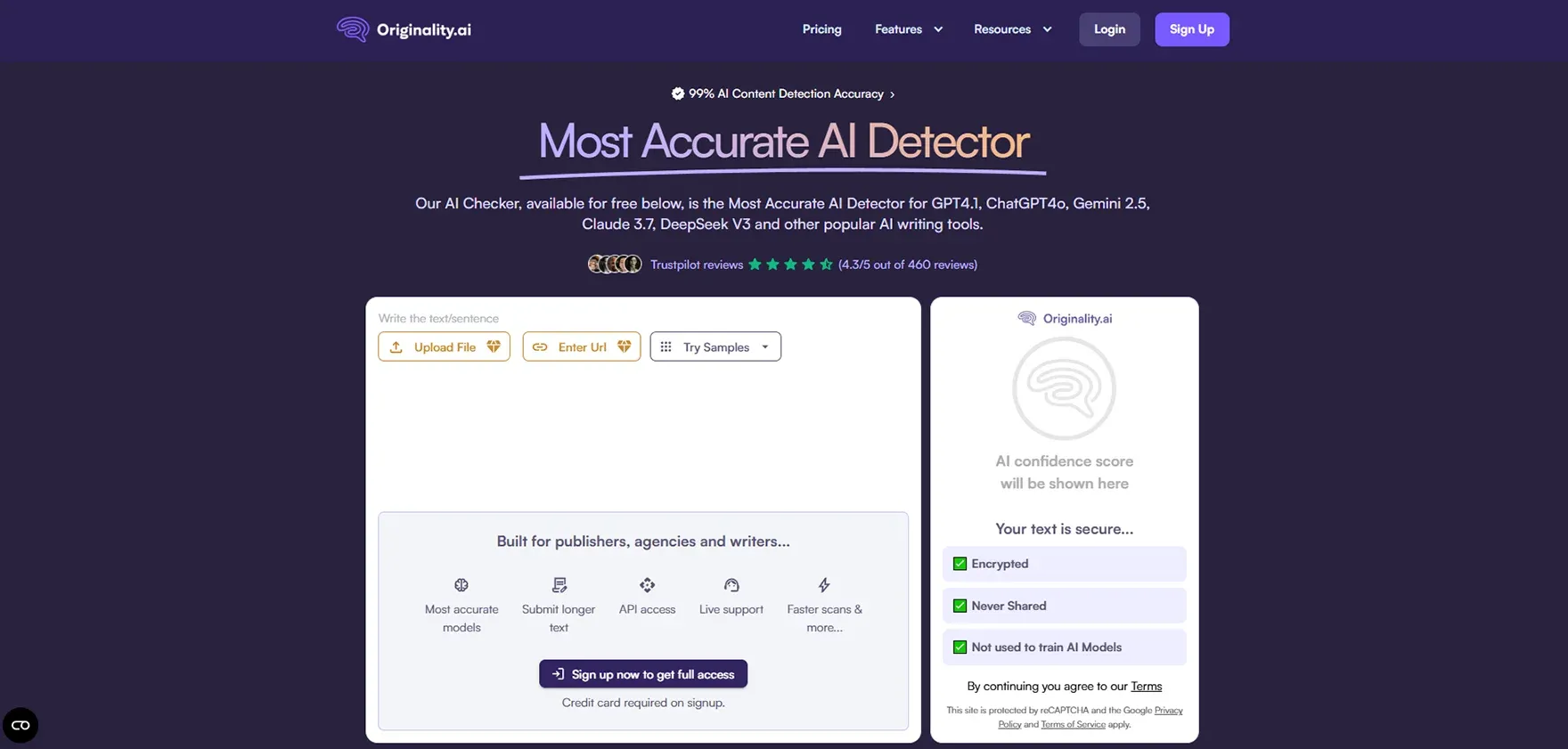
Conclusion
Cramly's AI detector is a low-cost and straightforward option, but it has limited capabilities in terms of accuracy and depth needed for substantial content verification. If you are a student or a casual user, it may suffice. However, if you need AI detection for academic, legal, or professional reasons, more precise instruments such as Bypassai.io would be a better choice.
Cramly might serve as a brief verification; however, relying on it alone is not advisable. At a time when Artificial Intelligence (AI) is being closely supervised, it becomes very important to select a trustworthy detection tool to retain the trust, integrity, and compliance of your work.
FAQs
1. Is the Cramly AI detector free?
Yes, it does have a free version, but with some restrictions on the number of uses and features.
2. Can I trust Cramly for academic AI detection?
Not entirely. A few experiments indicate that the detection accuracy of Cramly is less than that of more advanced tools such as Originality.ai or Bypassai.io.
3. What is the most accurate AI content detector in 2025?
Originality.ai and Bypassai.io are currently at the top of the list in terms of detection reliability, precision, and comprehensive reporting.
4. Is the plagiarism checking part of Cramly's services?
No, Cramly is centered on AI content creation and detection of simple AI only, so plagiarism is not one of its features. To detect plagiarism, you'd require a separate tool or a more powerful one, e.g., Copyleaks.
5. Is it possible for Cramly to find out if the text is produced by ChatGPT or other similar sources?
To some extent. Cramly can find some parts of AI-generated content from tools like ChatGPT, but it is not regular or complete; hence, it cannot be trusted for the verification of the most important content.

